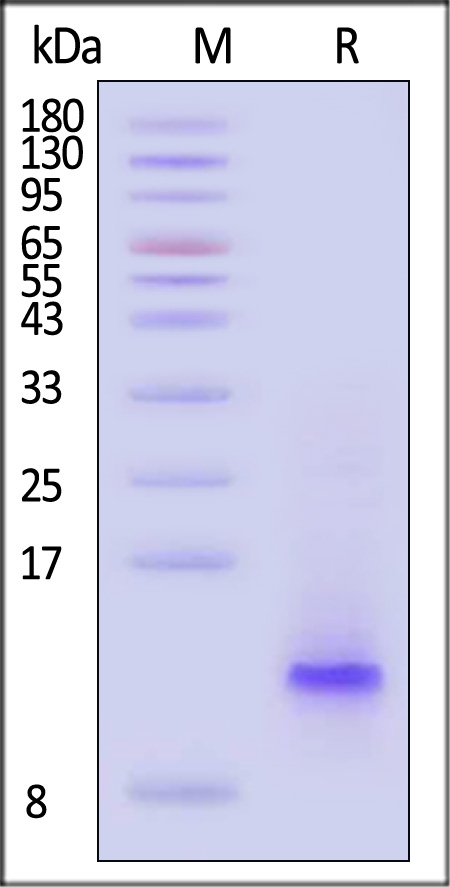分子别名(Synonym)
C-C motif chemokine 20,Beta-chemokine exodus-1,CC chemokine LARC,Liver and activation-regulated chemokine,Macrophage inflammatory protein 3 alpha,MIP-3-alpha,Small-inducible cytokine A20,CCL20
表达区间及表达系统(Source)
Human CCL20 Protein, His Tag (CC0-H51H3) is expressed from E. coli cells. It contains AA Ala 27 - Met 96 (Accession # P78556-1).
Predicted N-terminus: Met
Request for sequence
蛋白结构(Molecular Characterization)

This protein carries a polyhistidine tag at the C-terminus.
The protein has a calculated MW of 10 kDa. The protein migrates as 11-12 kDa when calibrated against Star Ribbon Pre-stained Protein Marker under reducing (R) condition (SDS-PAGE).
内毒素(Endotoxin)
Less than 1.0 EU per μg by the LAL method.
纯度(Purity)
>90% as determined by SDS-PAGE.
>90% as determined by SEC-HPLC.
制剂(Formulation)
Lyophilized from 0.22 μm filtered solution in 0.085% TFA 30% ACN with trehalose as protectant.
Contact us for customized product form or formulation.
重构方法(Reconstitution)
Please see Certificate of Analysis for specific instructions.
For best performance, we strongly recommend you to follow the reconstitution protocol provided in the CoA.
存储(Storage)
For long term storage, the product should be stored at lyophilized state at -20°C or lower.
Please avoid repeated freeze-thaw cycles.
This product is stable after storage at:
- -20°C to -70°C for 12 months in lyophilized state;
- -70°C for 3 months under sterile conditions after reconstitution.
电泳(SDS-PAGE)

Human CCL20 Protein, His Tag on SDS-PAGE under reducing (R) condition. The gel was stained with Coomassie Blue. The purity of the protein is greater than 90% (With Star Ribbon Pre-stained Protein Marker).
SEC-HPLC

The purity of Human CCL20 Protein, His Tag (Cat. No. CC0-H51H3) was greater than 90% as determined by SEC-HPLC.
背景(Background)
This antimicrobial gene belongs to the subfamily of small cytokine CC genes. Cytokines are a family of secreted proteins involved in immunoregulatory and inflammatory processes. The CC cytokines are proteins characterized by two adjacent cysteines. The protein encoded by this gene displays chemotactic activity for lymphocytes and can repress proliferation of myeloid progenitors. Two transcript variants encoding different isoforms have been found for this gene.























































 膜杰作
膜杰作 Star Staining
Star Staining











